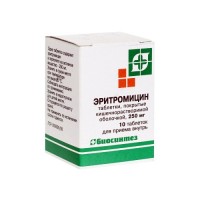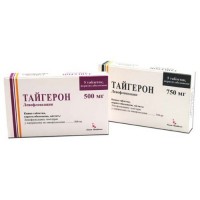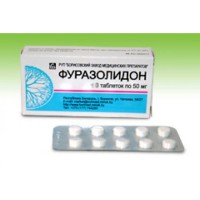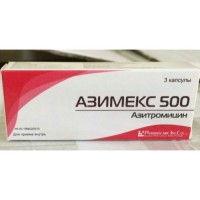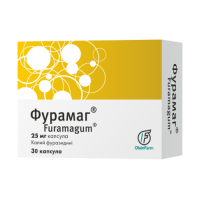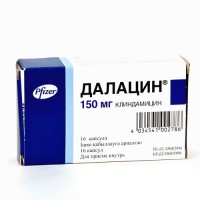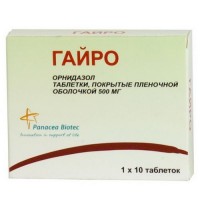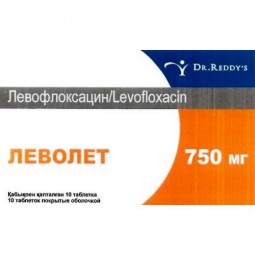The instruction for medical use
of KLAVAM medicine
the Trade name
Klavam
Mezhdunarodnoye the unlicensed name
Is not present
the Dosage form
of the Tablet, coated, 375 mg and 625 mg
Structure
One tablet, coated, contains
active agents: amoxicillin of trihydrate of 294.12 mg and 588.24 mg
(equivalent to amoxicillin of 250 mg and 500 mg)
clavulanate potassium in mix in avitsely (1: 1) 305 mg
(equivalent to clavulanic acid of 125 mg)
excipients: sodium of starch glikolit, sodium of a kroskarmeloz, silicon colloidal anhydrous, cellulose microcrystalline, the talc purified of magnesium stearate.
Structure of a cover: hydroksipropilmetiltsellyuloza of E-5, ethyl cellulose, diethyl phthalate, titan dioxide, polyethyleneglycol 6000, tal cleaned.
The description
of the Tablet, coated white color, a biconvex oval form with risky from two parties.
Pharmacotherapeutic group
Beta laktamnye antibacterial drugs – Penicillin. Penicillin in a combination with inhibitors beta laktamaz.
The code of automatic telephone exchange J01CR02
the Pharmacological
Pharmacokinetics Key Pharmacokinetic Parameters properties of amoxicillin and clavulanic acid are similar. Amoxicillin and clavulanic acid in a combination do not influence at each other.
Absorption: after intake both components of drug are quickly absorbed from digestive tract. The concomitant use of food does not influence absorption.
Distribution: the maximum concentration in blood plasma is reached approximately in 1 h and makes for amoxicillin (depending on a dose) 3-12 mkg/ml, for clavulanic acid – 2 mkg/ml. Both components are characterized by the good volume of distribution in liquids and body tissues (lungs, a middle ear, pleural and peritoneal liquids, a uterus, ovaries). Amoxicillin also gets into synovial fluid, a liver, a prostate, palatine tonsils, muscle tissue, a gall bladder, secretion of adnexal bosoms of a nose, saliva, bronchial secretion. Get through a blood-brain barrier at the inflamed meninx. The maximum concentration in liquids of an organism is observed in 1 h after achievement of the maximum concentration in blood plasma.
Active agents in low concentration are emitted with breast milk, get through a placental barrier. Linking with proteins of blood plasma for amoxicillin makes 17-20%, for clavulanic acid - 22-30%.
Removal: amoxicillin is removed generally by kidneys by canalicular secretion and glomerular filtration. Clavulanic acid is actively metabolized in a liver and removed by glomerular filtration, partially in the form of metabolites. Small amounts can be removed through intestines and lungs. Elimination half-life of amoxicillin makes 1-1.3 h, clavulanic acid – 1.2 h.
In a renal failure the removal of drug is slowed down therefore correction of the mode of dosing (dose decline and increase in intervals between administrations of drug) is necessary.
The pharmacodynamics
the Antibiotic of a broad spectrum of activity, contains semi-synthetic penicillin amoxicillin and inhibitor beta laktamaz clavulanic acid. Clavulanic acid inhibits the majority clinically significant beta laktamaz, the produced Staphylococcus spp., Escherichia coli, Proteus mirabilis, Haemophilus influenzae, Moraxella catarrhalis, Bacteroides spp. It is inactive concerning a beta laktamaz of 1 type produced by Enterobacter spp., Morganella morganii, Pseudomonas aeruginosa, Serratia spp., Acinetobacter spp.
This combination provides high bactericidal activity of Klavam (including concerning strains of the microorganisms resistant to amoxicillin). Clavulanic acid, having higher affinity to a beta laktamaze, than amoxicillin, forms the stable deactivated complex with enzyme, interfering with enzymatic degradation of amoxicillin under the influence of a beta laktamaz.
Thus, Klavam affects bakteritsidno a wide range of gram-positive and gram-negative bacteria (including strains which gained resistance to a beta laktamnym to antibiotics owing to products beta laktamaz).
Klavam is active concerning aerobic gram-positive bacteria: Streptococcus spp. (including Streptococcus pneumoniae, Streptococcus viridans, Streptococcus milleri, Streptococcus pyogenes, Streptococcus bovis), Enterococcus faecium, Staphylococcus aureus (except Methicillinum - resistant strains), Staphylococcus epidermidis (except Methicillinum - resistant strains), Corynebacterium spp., Listeria monocytogenes, Nocardia asteroides, aerobic gram-negative bacteria: Aeromonas spp., Bordetella pertussis, Brucella spp., Campylobacter jejuni, Campylobacter coli, Citrobacter spp. (are moderately sensitive), Escherichia coli, Gardnerella vaginalis, Haemophilus ducreyi, Haemophilus influenzae, Helicobacter pylori, Klebsiella spp., Legionella pneumophila, Moraxella catarrhalis, Morganella spp. (are moderately sensitive), Neisseria gonorrhoeae, Neisseria meningitidis, Pasteurella multocida, Proteus mirabilis, Proteus vulgaris, Providencia spp., Salmonella spp., Shigella spp., Vibrio cholerae, Yersinia enterocolitica (is moderately sensitive), anaerobic bacteria: Actinomyces israelii, Bacteroides spp. (including Bacteroides fragilis), Prevotella melaninogenica, Clostridium spp. (except Clostridium difficile), Peptostreptococcus spp., Eikenella corrodens, Fusobacterium spp., Propionibacterium spp., Treponema pallidum.
Mycobacterium chelonae is resistant to drug.
Indications
the Infectious and inflammatory diseases caused by microorganisms, sensitive to drug:
- infections of upper parts of airways (including acute and chronic sinusitis, retropharyngeal abscess, tonsillitis, pharyngitis)
- infections of lower parts of airways (including acute and chronic bronchitis with bacterial superinfection, pneumonia)
- acute and chronic otitis
- infections of urinary tract
- gynecologic infections
- infections of skin and soft tissues
- infections of bones and joints
- infections of bilious ways (cholecystitis, a cholangitis)
- shankroid
- gonorrhea
- dontogenous infections.
The route of administration and doses
to Adults and children are more senior than 12 years (or with body weight more than 40 kg) at an easy or medium-weight course of an infection each 8 h or on 1 tablet of 625 mg each 12 h, in case of a heavy course of an infection and respiratory infections appoint on 1 tablet 375 mg – on 1 tablet of 625 mg each 8 h.
The maximum daily dose for amoxicillin makes 6 g for adults and 45 mg/kg of body weight for children, for clavulanic acid - 600 mg for adults and 10 mg/kg for children.
The course of treatment makes 5-14 days. Duration of a course of treatment is defined by the attending physician. Treatment should not continue more than 14 days without repeated medical examination.
In dontogenous infections each 8 h or 1 tablet of 625 mg each 12 h within 5 days appoint on 1 tablet 375 mg.
In a renal failure of moderate degree (KK of 10-30 ml/min.) each 12 h appoint on 1 tablet 625 mg, in a renal failure of heavy degree (KK less than 10 ml/min.) – on 1 tablet of 625 mg each 24 h. At an anury it is necessary to increase an interval between receptions of doses up to 48 h and more.
Side effects
Are possible
- loss of appetite, nausea, vomiting, diarrhea, change of coloring of adamantine substance of tooth Is rare
- pseudomembranous colitis from heavy diarrheas
- an erythema, skin rash, an itching, predisposed patients have reactions of immediate hypersensitivity (Quincke's disease, a bronchospasm, an acute anaphylaxis)
- development of superinfection (stomatitis, a vaginitis, dysbacteriosis, candidiasis)
- insomnia, excitement, dizziness, confusion consciousness, convulsive reactions
- joint pains
- interstitial nephrite, a crystalluria, a leukopenia, thrombocytopenia
- tachycardia
In isolated cases
- tranzitorny increase in activity of liver enzymes, cholestatic jaundice, hepatitis, abnormal liver functions
-
Contraindications
- hypersensitivity to antibiotics of group of penicillin in
the anamnesis
- hypersensitivity to amoxicillin or clavulanic acid or other components of drug
- an infectious mononucleosis
- a lymphoid leukosis
- a liver failure
- the cholestatic jaundice or hepatitis caused by reception of antibiotics of group of penicillin in the anamnesis
- bronchial asthma, a senny pollinosis
- the children's age up to 12 years
Medicinal interactions
At simultaneous use of Klavam and indirect anticoagulants is noted increase in a prothrombin time. Therefore this combination is appointed with care.
At simultaneous use of Klavam with Allopyrinolum the risk of development of such side effects as a dieback increases.
At simultaneous use Klavam enhances toxicity of a methotrexate.
The amoxicillin combination with rifampicin is antagonistic (mutual weakening of antibacterial action is noted).
Klavam it is not necessary to apply along with bacteriostatic antibiotics (macroleads, tetracyclines), streptocides because of possible decrease in efficiency of Klavam.
At simultaneous use Klavam reduces efficiency of oral contraceptives.
Probenetsid reduces renal canalicular secretion of amoxicillin. Simultaneous use with Klavam can lead it to the increased amoxicillin level in blood, however, it is not observed concerning clavulanic acid. As well as the efficiency of oral contraceptives can reduce other antibiotics of a broad spectrum of activity of Klavam. In certain cases drug can extend a prothrombin time, for this reason it is necessary to be careful at simultaneous use of oral anticoagulants and Klavama.
Special instructions
With care appoint drug to the patients inclined to allergic reactions and also patients with the known hypersensitivity to antibiotics of a tsefalosporinovy row since there is a risk of development of cross sensitivity.
Periodic control of function of a liver is required from patients with abnormal liver functions.
Adequate correction of the mode of dosing or increase in intervals between dosing is required from patients with heavy renal failures.
For the purpose of reduction of risk of development of side reactions from digestive tract it is necessary to take the drug at meal time.
Because at a large number of the patients with an infectious mononucleosis and a lymphoid leukosis receiving ampicillin observed appearance of erythematic rash, use of antibiotics of group of ampicillin for such patients is not recommended.
At use Klavama is possible false positive reaction when determining level of glucose in urine when using a reactant of Benedict or Fellinga solution (recommend to apply enzymatic reactions with glucose oxydas).
It is necessary to avoid co-administration with Disulfiramum.
As tablets of 375 mg (250/125) and 625 mg (500/125) contain identical amount of clavulanic acid – 125 mg, but different amount of amoxicillin, 2 tablets of 375 mg are not equivalent to 1 tablet of 625 mg.
Use in pediatrics
Drug in the form of tablets, coated, is not appointed to children 12 years are younger (with body weight less than 40 kg).
Pregnancy and the period of a lactation
Prescribing of drug at pregnancy is possible only if the expected advantage for mother exceeds potential risk for a fruit or the child.
Amoxicillin and clavulanic acid get in small amounts into breast milk therefore it is necessary to stop breastfeeding during administration of drug.
Features of influence on ability to run transport and potentially dangerous
Klavam mechanisms have extremely weak impact on ability to drive the car and difficult mechanisms.
In extremely exceptional cases amoxicillin/clavulanic acid can cause such undesirable reactions as confusion of consciousness, dizziness and spasms which can break ability to run the vehicle and difficult mechanisms and/or it is safe to work.
The overdose
is not available messages about a lethal outcome or emergence of life-threatening side effects owing to drug overdose.
Symptoms: an abdominal pain, diarrhea, vomiting, it is possible also uneasiness, excitement, insomnia, dizziness, in some cases - spasms.
Treatment: in case of recent administration of drug (less than 4 h) it is necessary to carry out gastric lavage and to appoint activated carbon for drug absorption reduction, if necessary carry out symptomatic therapy. The hemodialysis is effective.
Form of release and packing
of the Tablet, coated, 375 mg or 625 mg.
On 10 tablets in blisters from aluminum foil. On 2 blisters together with the instruction for medical use in the state and Russian languages place in a pack from cardboard.
To Store storage conditions at a temperature not above 25 °C, in the dry, protected from light place.
To store drug out of children's reach!
2 years
not to use a period of storage after the expiration date specified on packing.
Prescription status
According to the prescription
the Name and the address
of Alkem Laboratories Ltd producer Alkem Hourse "Devashish", Senapati Bapat Marg, Lower Parel, Mumbai – 400013, India
the Address of the organization accepting in the territory of the Republic of Kazakhstan claims from consumers on quality of products (goods)
Representative office
" Alkem Laboratories Ltd" in RK
acting through the authorized representative
of the Chief representative
Sandipa Kumar Dubeya
Almaty, Mametov St. 67/7
of E.mail:
Ph./fax: 266-3990, 275-69-65
To develop dubeysand@yahoo.com
of KLAVAM medicine
the Trade name
Klavam
Mezhdunarodnoye the unlicensed name
Is not present
the Dosage form
of the Tablet, coated, 375 mg and 625 mg
Structure
One tablet, coated, contains
active agents: amoxicillin of trihydrate of 294.12 mg and 588.24 mg
(equivalent to amoxicillin of 250 mg and 500 mg)
clavulanate potassium in mix in avitsely (1: 1) 305 mg
(equivalent to clavulanic acid of 125 mg)
excipients: sodium of starch glikolit, sodium of a kroskarmeloz, silicon colloidal anhydrous, cellulose microcrystalline, the talc purified of magnesium stearate.
Structure of a cover: hydroksipropilmetiltsellyuloza of E-5, ethyl cellulose, diethyl phthalate, titan dioxide, polyethyleneglycol 6000, tal cleaned.
The description
of the Tablet, coated white color, a biconvex oval form with risky from two parties.
Pharmacotherapeutic group
Beta laktamnye antibacterial drugs – Penicillin. Penicillin in a combination with inhibitors beta laktamaz.
The code of automatic telephone exchange J01CR02
the Pharmacological
Pharmacokinetics Key Pharmacokinetic Parameters properties of amoxicillin and clavulanic acid are similar. Amoxicillin and clavulanic acid in a combination do not influence at each other.
Absorption: after intake both components of drug are quickly absorbed from digestive tract. The concomitant use of food does not influence absorption.
Distribution: the maximum concentration in blood plasma is reached approximately in 1 h and makes for amoxicillin (depending on a dose) 3-12 mkg/ml, for clavulanic acid – 2 mkg/ml. Both components are characterized by the good volume of distribution in liquids and body tissues (lungs, a middle ear, pleural and peritoneal liquids, a uterus, ovaries). Amoxicillin also gets into synovial fluid, a liver, a prostate, palatine tonsils, muscle tissue, a gall bladder, secretion of adnexal bosoms of a nose, saliva, bronchial secretion. Get through a blood-brain barrier at the inflamed meninx. The maximum concentration in liquids of an organism is observed in 1 h after achievement of the maximum concentration in blood plasma.
Active agents in low concentration are emitted with breast milk, get through a placental barrier. Linking with proteins of blood plasma for amoxicillin makes 17-20%, for clavulanic acid - 22-30%.
Removal: amoxicillin is removed generally by kidneys by canalicular secretion and glomerular filtration. Clavulanic acid is actively metabolized in a liver and removed by glomerular filtration, partially in the form of metabolites. Small amounts can be removed through intestines and lungs. Elimination half-life of amoxicillin makes 1-1.3 h, clavulanic acid – 1.2 h.
In a renal failure the removal of drug is slowed down therefore correction of the mode of dosing (dose decline and increase in intervals between administrations of drug) is necessary.
The pharmacodynamics
the Antibiotic of a broad spectrum of activity, contains semi-synthetic penicillin amoxicillin and inhibitor beta laktamaz clavulanic acid. Clavulanic acid inhibits the majority clinically significant beta laktamaz, the produced Staphylococcus spp., Escherichia coli, Proteus mirabilis, Haemophilus influenzae, Moraxella catarrhalis, Bacteroides spp. It is inactive concerning a beta laktamaz of 1 type produced by Enterobacter spp., Morganella morganii, Pseudomonas aeruginosa, Serratia spp., Acinetobacter spp.
This combination provides high bactericidal activity of Klavam (including concerning strains of the microorganisms resistant to amoxicillin). Clavulanic acid, having higher affinity to a beta laktamaze, than amoxicillin, forms the stable deactivated complex with enzyme, interfering with enzymatic degradation of amoxicillin under the influence of a beta laktamaz.
Thus, Klavam affects bakteritsidno a wide range of gram-positive and gram-negative bacteria (including strains which gained resistance to a beta laktamnym to antibiotics owing to products beta laktamaz).
Klavam is active concerning aerobic gram-positive bacteria: Streptococcus spp. (including Streptococcus pneumoniae, Streptococcus viridans, Streptococcus milleri, Streptococcus pyogenes, Streptococcus bovis), Enterococcus faecium, Staphylococcus aureus (except Methicillinum - resistant strains), Staphylococcus epidermidis (except Methicillinum - resistant strains), Corynebacterium spp., Listeria monocytogenes, Nocardia asteroides, aerobic gram-negative bacteria: Aeromonas spp., Bordetella pertussis, Brucella spp., Campylobacter jejuni, Campylobacter coli, Citrobacter spp. (are moderately sensitive), Escherichia coli, Gardnerella vaginalis, Haemophilus ducreyi, Haemophilus influenzae, Helicobacter pylori, Klebsiella spp., Legionella pneumophila, Moraxella catarrhalis, Morganella spp. (are moderately sensitive), Neisseria gonorrhoeae, Neisseria meningitidis, Pasteurella multocida, Proteus mirabilis, Proteus vulgaris, Providencia spp., Salmonella spp., Shigella spp., Vibrio cholerae, Yersinia enterocolitica (is moderately sensitive), anaerobic bacteria: Actinomyces israelii, Bacteroides spp. (including Bacteroides fragilis), Prevotella melaninogenica, Clostridium spp. (except Clostridium difficile), Peptostreptococcus spp., Eikenella corrodens, Fusobacterium spp., Propionibacterium spp., Treponema pallidum.
Mycobacterium chelonae is resistant to drug.
Indications
the Infectious and inflammatory diseases caused by microorganisms, sensitive to drug:
- infections of upper parts of airways (including acute and chronic sinusitis, retropharyngeal abscess, tonsillitis, pharyngitis)
- infections of lower parts of airways (including acute and chronic bronchitis with bacterial superinfection, pneumonia)
- acute and chronic otitis
- infections of urinary tract
- gynecologic infections
- infections of skin and soft tissues
- infections of bones and joints
- infections of bilious ways (cholecystitis, a cholangitis)
- shankroid
- gonorrhea
- dontogenous infections.
The route of administration and doses
to Adults and children are more senior than 12 years (or with body weight more than 40 kg) at an easy or medium-weight course of an infection each 8 h or on 1 tablet of 625 mg each 12 h, in case of a heavy course of an infection and respiratory infections appoint on 1 tablet 375 mg – on 1 tablet of 625 mg each 8 h.
The maximum daily dose for amoxicillin makes 6 g for adults and 45 mg/kg of body weight for children, for clavulanic acid - 600 mg for adults and 10 mg/kg for children.
The course of treatment makes 5-14 days. Duration of a course of treatment is defined by the attending physician. Treatment should not continue more than 14 days without repeated medical examination.
In dontogenous infections each 8 h or 1 tablet of 625 mg each 12 h within 5 days appoint on 1 tablet 375 mg.
In a renal failure of moderate degree (KK of 10-30 ml/min.) each 12 h appoint on 1 tablet 625 mg, in a renal failure of heavy degree (KK less than 10 ml/min.) – on 1 tablet of 625 mg each 24 h. At an anury it is necessary to increase an interval between receptions of doses up to 48 h and more.
Side effects
Are possible
- loss of appetite, nausea, vomiting, diarrhea, change of coloring of adamantine substance of tooth Is rare
- pseudomembranous colitis from heavy diarrheas
- an erythema, skin rash, an itching, predisposed patients have reactions of immediate hypersensitivity (Quincke's disease, a bronchospasm, an acute anaphylaxis)
- development of superinfection (stomatitis, a vaginitis, dysbacteriosis, candidiasis)
- insomnia, excitement, dizziness, confusion consciousness, convulsive reactions
- joint pains
- interstitial nephrite, a crystalluria, a leukopenia, thrombocytopenia
- tachycardia
In isolated cases
- tranzitorny increase in activity of liver enzymes, cholestatic jaundice, hepatitis, abnormal liver functions
-
Contraindications
- hypersensitivity to antibiotics of group of penicillin in
the anamnesis
- hypersensitivity to amoxicillin or clavulanic acid or other components of drug
- an infectious mononucleosis
- a lymphoid leukosis
- a liver failure
- the cholestatic jaundice or hepatitis caused by reception of antibiotics of group of penicillin in the anamnesis
- bronchial asthma, a senny pollinosis
- the children's age up to 12 years
Medicinal interactions
At simultaneous use of Klavam and indirect anticoagulants is noted increase in a prothrombin time. Therefore this combination is appointed with care.
At simultaneous use of Klavam with Allopyrinolum the risk of development of such side effects as a dieback increases.
At simultaneous use Klavam enhances toxicity of a methotrexate.
The amoxicillin combination with rifampicin is antagonistic (mutual weakening of antibacterial action is noted).
Klavam it is not necessary to apply along with bacteriostatic antibiotics (macroleads, tetracyclines), streptocides because of possible decrease in efficiency of Klavam.
At simultaneous use Klavam reduces efficiency of oral contraceptives.
Probenetsid reduces renal canalicular secretion of amoxicillin. Simultaneous use with Klavam can lead it to the increased amoxicillin level in blood, however, it is not observed concerning clavulanic acid. As well as the efficiency of oral contraceptives can reduce other antibiotics of a broad spectrum of activity of Klavam. In certain cases drug can extend a prothrombin time, for this reason it is necessary to be careful at simultaneous use of oral anticoagulants and Klavama.
Special instructions
With care appoint drug to the patients inclined to allergic reactions and also patients with the known hypersensitivity to antibiotics of a tsefalosporinovy row since there is a risk of development of cross sensitivity.
Periodic control of function of a liver is required from patients with abnormal liver functions.
Adequate correction of the mode of dosing or increase in intervals between dosing is required from patients with heavy renal failures.
For the purpose of reduction of risk of development of side reactions from digestive tract it is necessary to take the drug at meal time.
Because at a large number of the patients with an infectious mononucleosis and a lymphoid leukosis receiving ampicillin observed appearance of erythematic rash, use of antibiotics of group of ampicillin for such patients is not recommended.
At use Klavama is possible false positive reaction when determining level of glucose in urine when using a reactant of Benedict or Fellinga solution (recommend to apply enzymatic reactions with glucose oxydas).
It is necessary to avoid co-administration with Disulfiramum.
As tablets of 375 mg (250/125) and 625 mg (500/125) contain identical amount of clavulanic acid – 125 mg, but different amount of amoxicillin, 2 tablets of 375 mg are not equivalent to 1 tablet of 625 mg.
Use in pediatrics
Drug in the form of tablets, coated, is not appointed to children 12 years are younger (with body weight less than 40 kg).
Pregnancy and the period of a lactation
Prescribing of drug at pregnancy is possible only if the expected advantage for mother exceeds potential risk for a fruit or the child.
Amoxicillin and clavulanic acid get in small amounts into breast milk therefore it is necessary to stop breastfeeding during administration of drug.
Features of influence on ability to run transport and potentially dangerous
Klavam mechanisms have extremely weak impact on ability to drive the car and difficult mechanisms.
In extremely exceptional cases amoxicillin/clavulanic acid can cause such undesirable reactions as confusion of consciousness, dizziness and spasms which can break ability to run the vehicle and difficult mechanisms and/or it is safe to work.
The overdose
is not available messages about a lethal outcome or emergence of life-threatening side effects owing to drug overdose.
Symptoms: an abdominal pain, diarrhea, vomiting, it is possible also uneasiness, excitement, insomnia, dizziness, in some cases - spasms.
Treatment: in case of recent administration of drug (less than 4 h) it is necessary to carry out gastric lavage and to appoint activated carbon for drug absorption reduction, if necessary carry out symptomatic therapy. The hemodialysis is effective.
Form of release and packing
of the Tablet, coated, 375 mg or 625 mg.
On 10 tablets in blisters from aluminum foil. On 2 blisters together with the instruction for medical use in the state and Russian languages place in a pack from cardboard.
To Store storage conditions at a temperature not above 25 °C, in the dry, protected from light place.
To store drug out of children's reach!
2 years
not to use a period of storage after the expiration date specified on packing.
Prescription status
According to the prescription
the Name and the address
of Alkem Laboratories Ltd producer Alkem Hourse "Devashish", Senapati Bapat Marg, Lower Parel, Mumbai – 400013, India
the Address of the organization accepting in the territory of the Republic of Kazakhstan claims from consumers on quality of products (goods)
Representative office
" Alkem Laboratories Ltd" in RK
acting through the authorized representative
of the Chief representative
Sandipa Kumar Dubeya
Almaty, Mametov St. 67/7
of E.mail:
Ph./fax: 266-3990, 275-69-65
To develop dubeysand@yahoo.com

